When you visit Japan, you cannot miss out on the Japanese food culture. Ramen is amongst the popular ones of them. Depending on the type of ramen shop you enter in, ramen is commonly served with the shop’s own decision of what kinds of noodles, broth thickness, and toppings to use. However, if you eat at a shop like 一蘭 (ichiran) or 一風堂 (ippudō), some shops allow you to customize your own ramen or a part of it!
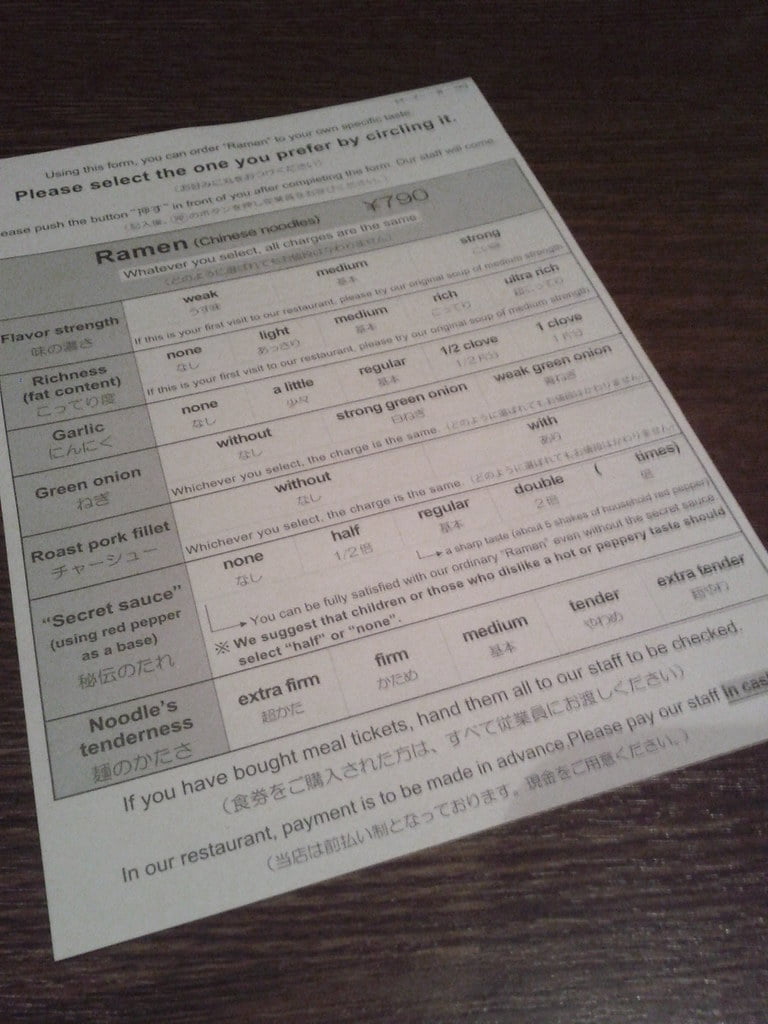
“Options” by mrjoro is licensed under CC BY-NC 2.0
If you have a chance to customize your own ramen, here we help you to create your best bowl of ramen, by introducing useful vocabularies to use when ordering and understanding the ramen menu.
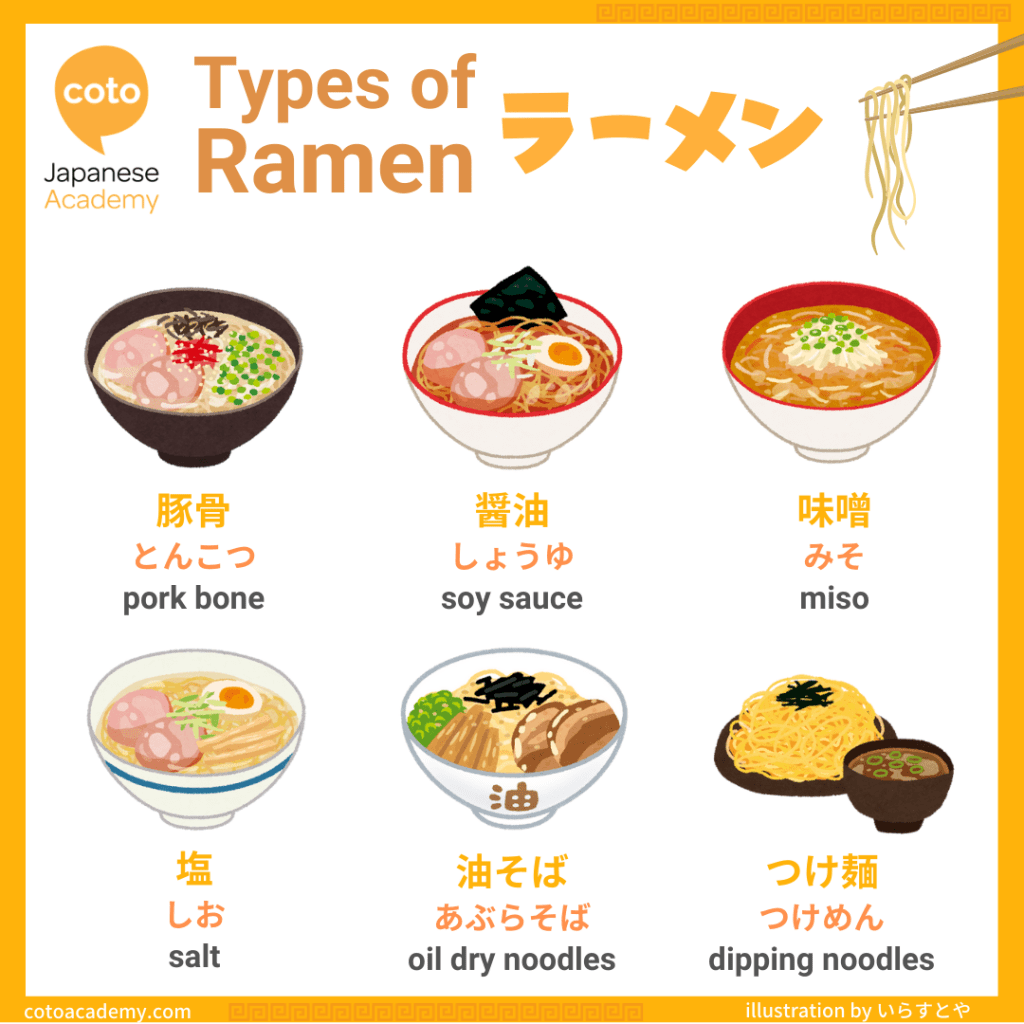
To begin with, there are many types of ramen in Japan. It is essential to understand the difference between each ramen and know the taste differences. These are amongst the popular types eaten in Japan.
- 豚骨 -とんこつ (tonkotsu) – rich and creamy pork broth. Originated in Fukuoka prefecture
- 醤油 -しょうゆ (shōyū) – soy sauce based soup
- 味噌 -みそ (miso) – miso based soup
- 塩 -しお (shio) – salt based soup
- 油そば -あぶらそば (abura soba) – oil dry soba
- つけ麺 -つけめん (tsukemen) – dipping noodles in a thick broth.
Did you know that ramen broth is commonly made from pork, cooked at a low temperature for as short as 3~4 hours, as long as 12 hours? Because the broth is brewed at low heat for very long hours, this creates a nice depth in the taste of ramen broth.
As Japanese tourism has grown over the past decade, ramen shops have also widened their inclusivity. The popular ramen above contains a kind of animal broth. However, to acknowledge the various diets out there, popular ramen shops like 一風堂 (ippudō) has created plant-based broth for vegetarian and vegan customers so that everyone can enjoy this particular food.
Shin-Yokohama Ramen Museum
Have you ever heard of a ramen museum in Yokohama? This museum is located in the neighboring prefecture of Tokyo in Kanagawa. It is highly accessible, where it is less than 30 minutes by train from Shibuya to Shin-Yokohama. This museum features the history of Ramen, telling you all you need to know about Ramen. This museum is also well known for the number of Ramen shops located throughout the building.
Watch this Youtuber introduce and eat all the different types of Ramen in the museum! You will definitely want to pop a visit to the museum after this.
This video is in Japanese, you can watch it for your listening practice!
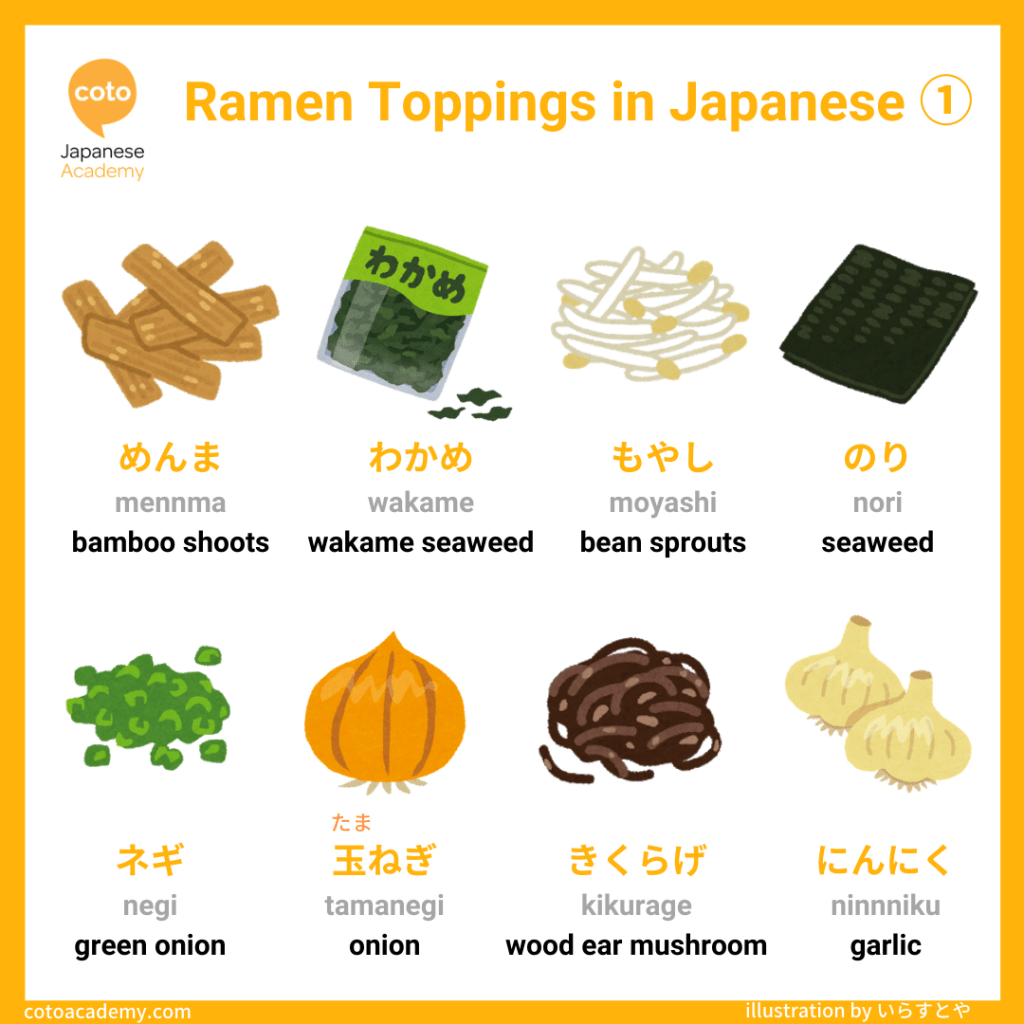
Secondly, in order to customize to their liking, ramen shops have options for you to add extra of your favorite ones, with an additional price. These are common toppings available at ramen shops. Many of these toppings are often eaten in Japan, and may be unfamiliar to those that have not visited Japan before. めんま (menma) are bamboo shoots that have been fermented. It has a salted pickled taste, which is a perfect combination for noodles. This is a topping that accompanies all noodles. Many Japanese people also love to eat めんま as a side dish pairing with beer or other alcohol.

In many ramen shops, you get one serving of ramen, with one serving size of toppings as well. On top of that, you can also order extra of your favorite toppings to further enjoy your meal.
Fun fact: Did you know you are able to order an extra serving of noodles as well? This is called 替え玉 or かえだま (kaedama).
Here is how you can ask for extra noodles:
Customer:
すみません!替え玉を追加してください!
sumimasen! kaedama wo tsuika shitekudasai!
Excuse me! Could you please add another serving of noodles?
Staff:
はいよ!
haiyo!
Sure!
If you are not fond of the certain topping, some places might be nice enough to let you order without it like this:
Customer:
すみません、コーンを抜いてもらうことができますか?
sumimasen, kōn wo nuite morau koto ga dekimasuka?
Excuse me, can I order this without corn?
Staff
もちろんです。
mochiron desu.
Of course.

This section compiles vocabularies that describe the richness of the ramen broth. People have various preferences in how their ramen broth tastes, varying from a bland to salty and rich taste.
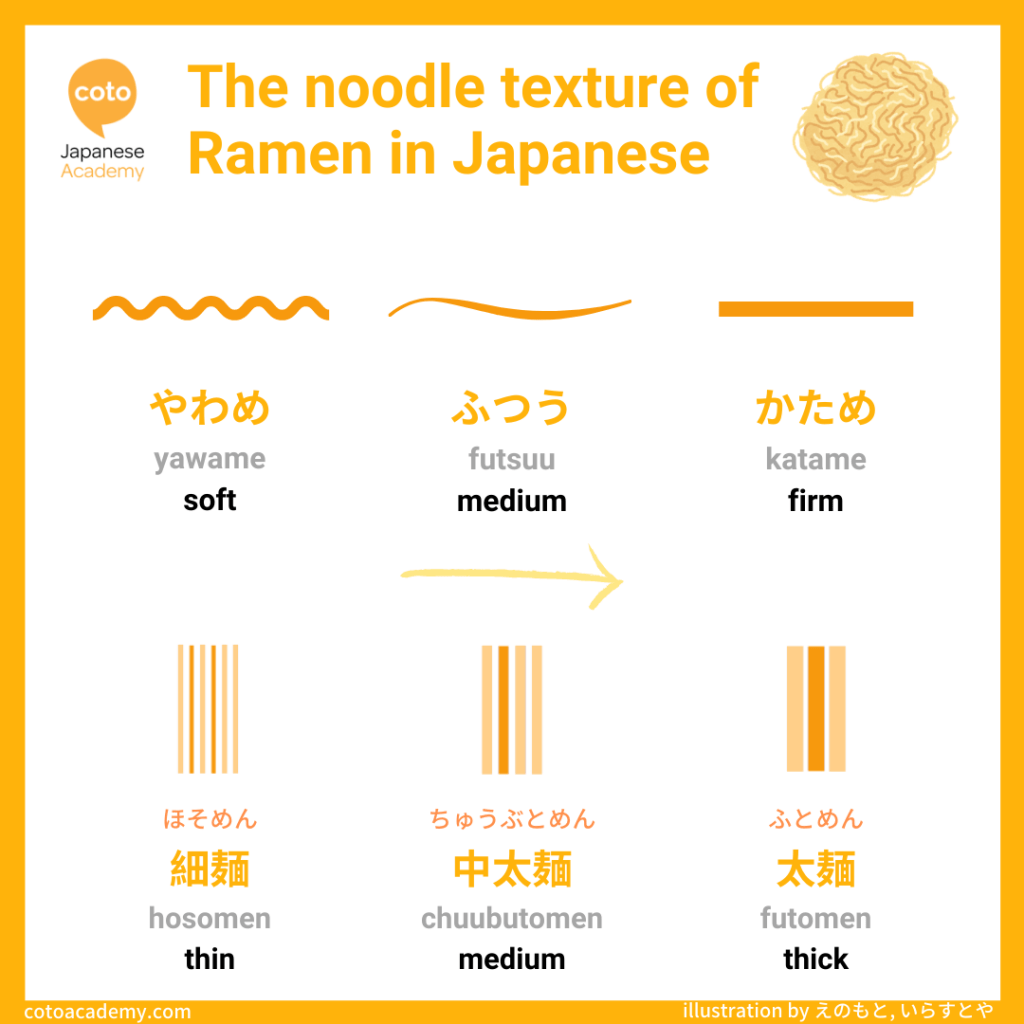
Many popular ramen shops in Japan allow you to select the texture of the noodles. For example, shops like 一風堂 (ippudō) and 一蘭 (ichi ran).
一風堂 (ippudō) has a scale of normal firmness to three scales of noodle firmness. Whereas 一蘭 (ichi ran) has five scales, from very soft to very hard noodle texture. From this, you can see that each ramen shop has its own preference according to its ramen broth.
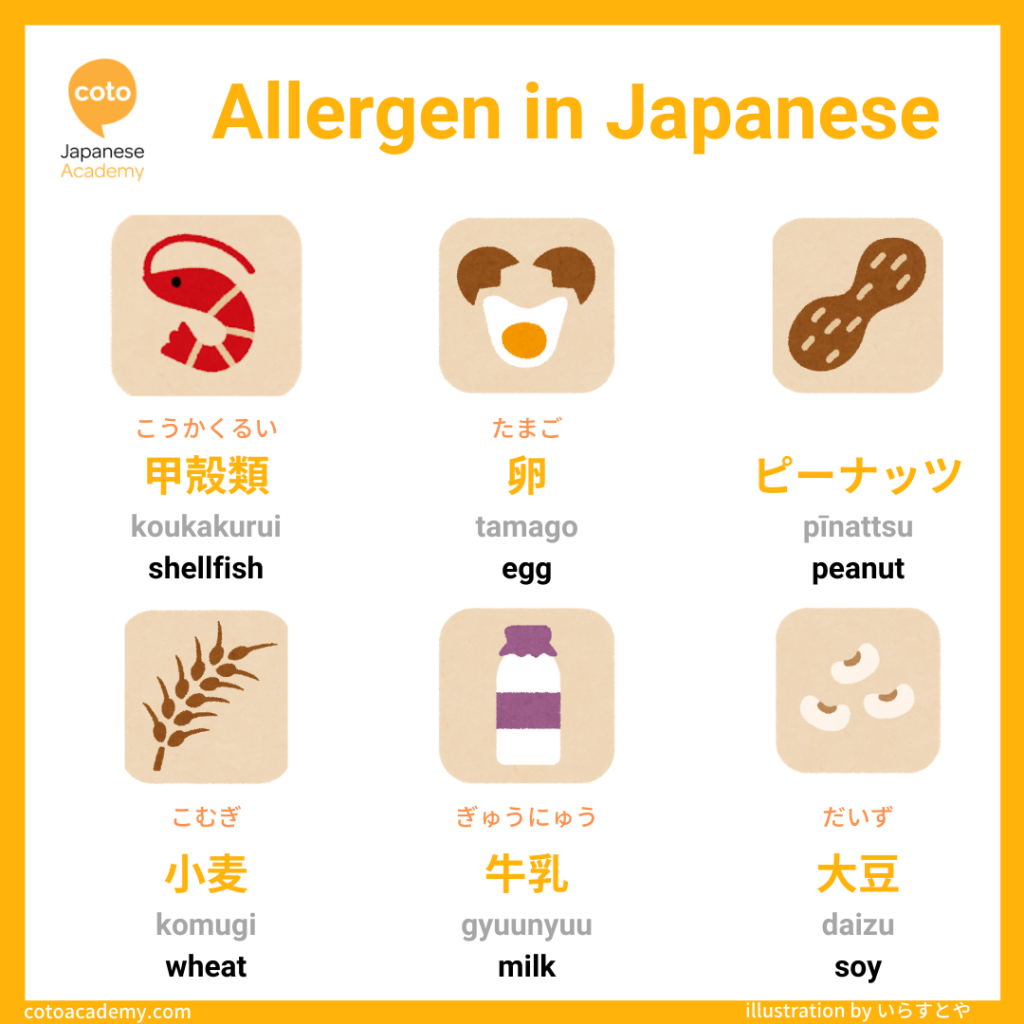
If you are someone that has a history of food allergies, make sure to look out for these allergens. It is crucial to familiarize yourself with these allergens, as many Japanese foods contain them.
If the menu does not mention the possible allergens contained here is a useful phrase to help you!
Customer:
すみません!油そばに甲殻類入ってますか?
sumimasen! aburasoba ni koukakurui haitte masuka?
Excuse me, does the oil dry noodles have shellfish in it?
Staff
入ってませんのでご安心してください!
haitte masen no de goanshin shite kudasai!
Please rest assured that it’s not in it.
Top 14 Ramen shops in Tokyo
If you are unsure of which ramen shop to eat at, have a look at this video introducing the best ramen shops in Tokyo!
We hope this guide has been useful to help you customize your favorite ramen! With the various ramen types out there, you can make so many different combinations of ramen. If you still have no clue where to begin with, just experiment and you will get there eventually!
